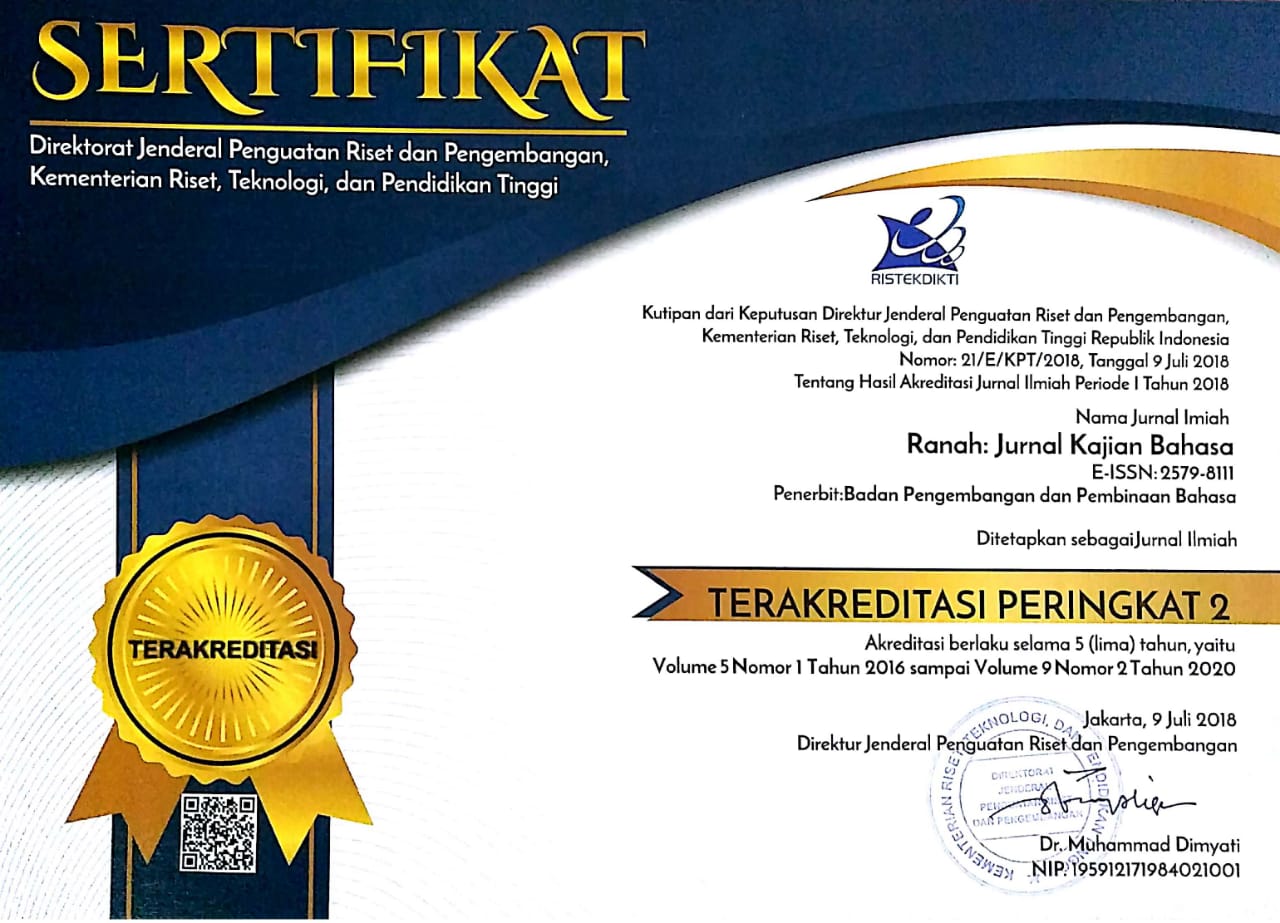Exploring EFL Teachers’ Teaching Process in Reading PISA-Like Reading Texts
Abstract
This paper presents partial results of a research project aiming to develop a training program for teachers to teach PISA-like reading texts with 24 participating teachers (10 Indonesian language teachers and 14 English language teachers) conducted in 2021. The result of the study has also been reported in Emilia, Sujatna, and Kurniasih (2022). This study centers around the early stage of training, focusing on the teachers’ initial ability in teaching reading practice prior to the training. The data were collected from peer teaching and lesson plans made by the teachers prior to the sessions on teaching PISA-like reading texts. The data were then analyzed based on the theory of PISA Reading (OECD, 2019), reading as a social process (Wallace, 1992; Gibbons, 2014), and teaching reading through the use of text-based instructions (Emilia, 2011; Rose & Martin, 2012; Rose, 2020). The result of the study shows that some teachers had bridged the students’ access to text by activating their prior knowledge to help them understand the text. Nevertheless, some teachers had not provided guidance for the students when they read. This result suggests that the teachers still need guidance to teach reading, especially in teaching PISA-like reading texts. Hence, the data confirm the need for training teachers to teach PISA-like reading texts.
Abstrak
Jurnal ini menyajikan sebagian hasil dari proyek penelitian yang bertujuan untuk mengembangkan program pelatihan bagi guru untuk mengajar teks membaca setara PISA dengan 24 guru peserta (10 guru bahasa Indonesia dan 14 guru bahasa Inggris) yang dilakukan pada tahun 2021. Bagian lain dari proyek penelitian ini juga telah telah dilaporkan dalam Emilia, Sujatna, dan Kurniasih (2022). Studi ini berpusat pada tahap awal pelatihan, yang berfokus pada kemampuan awal guru dalam mengajarkan membaca sebelum diberikan input pelatihan. Data penelitian diperoleh dari sesi peer teaching dan RPP yang dibuat oleh guru sebelum diberikan sesi input pengajaran teks bacaan mirip PISA. Data penelitian kemudian dianalisis berdasarkan teori PISA Reading (OECD, 2019), membaca sebagai proses sosial (Wallace, 1992; Gibbons, 2014), dan pengajaran bahasa berbasis teks (Emilia, 2011; Rose & Martin, 2012; Mawar, 2020). Hasil penelitian menunjukkan bahwa beberapa guru terlihat mampu untuk menjembatani akses siswa untuk membaca teks dengan mengaktifkan pengetahuan awal mereka yang dapat membantu mereka memahami teks. Namun demikian, beberapa guru terlihat masih belum memberikan bimbingan kepada siswa ketika mereka membaca. Hasil ini menunjukkan bahwa guru masih membutuhkan bimbingan untuk mengajar membaca, terutama dalam mengajar teks bacaan mirip PISA. Oleh karena itu, data mengkonfirmasi perlunya pelatihan guru untuk mengajar teks bacaan seperti PISA.
Keywords
Full Text:
PDFReferences
Alexander, P. A., Fox, E., Maggioni, L., Loughlin, S. M., Baggetta, P., Dinsmore, D. L., Grossnickle, E. M., List, A., Parkinson, M. M., Winters, F. I., & Dumas, D. (2012). Reading into the future: Competence for the 21st century. Educational Psychologist, 47(4), 259-280. https://doi.org/10.1080/00461520.2012.722511
Anderson, N. (1999). Exploring second language: Issues and strategies. Heinle & Heinle.
Ashcraft, N. (2014). Lesson planning (English language teacher development). TESOL Press.
Baecher, L., Farnsworth, T., & Ediger, A. (2014). The challenges of planning language objectives in content-based ESL instruction. Language Teaching Research, 18(1), 118-136. https://doi.org/10.1177/1362168813505381
Becker, M., McElvany, N., & Kortenbruck, M. (2010). Intrinsic and extrinsic reading motivation as predictors of reading literacy: A longitudinal study. Journal of Educational Psychology, 102(4), https://doi.org/10.1037/a0020084
Borko, H., & Livingston, C. (1989). Cognition and Improvisation: Differences in Mathematics Instruction by Expert and Novice Teachers. American Educational Research Journal, 26(4), 473-498. https://doi.org/10.3102/00028312026004473
Braun, V., & Clarke, V. (2006). Using thematic analysis in psychology. Qualitative Research in Psychology, 3(2), 77-101. https://doi.org/10.1191/1478088706qp063oa
Bruner, J. (1983). Child's talk: Learning to use language. Oxford University Press.
Cahyono, B. Y., & Widiati, U. (2005). The teaching of EFL reading in the Indonesian context: The state of the art. TEFLIN Journal, 17(1), 36-58.
Cohen, L., Manion, L., & Morrison, K. (2018). Research methods in education (8th ed.). Routledge. https://doi.org/10.4324/9781315456539
Cresswell, J. W. (2013). Qualitative inquiry & research design: Choosing among five approaches (3rd.). Sage Publication.
Day, R. (2020). Teaching reading, revised. TESOL International Association.
Duke, N. K., & Pearson, P. D. (2009). Effective practices for developing reading comprehension. Journal of Education, 189(1-2), 107-122. https://doi.org/10.1177/0022057409189001-208
Emilia, E. (2011). Pendekatan genre-based dalam pengajaran Bahasa Inggris: petunjuk untuk guru. Rizki Press.
Emilia, E., Tuckyta, E., Sujatna, S., & Kurniasih, N. (2022). Training teachers to teach PISA-like reading: A case in Indonesia. Indonesian Journal of Applied Linguistics, 12(1), 58-78. https://doi.org/10.17509/ijal.v12i1.46534
Fadhillah, A. M., & Emilia, E. (2022). A closer look at teachers' ability in developing PISA-like reading materials. . Manuscript Submitted for Publication.
Farrell, T. S. C. (2009). Teaching reading to English language learners. Corwin Press.
Farrell, T. S. C., & Bennis, K. (2013). Reflecting on ESL Teacher Beliefs and Classroom Practices: A Case Study. RELC Journal, 44(2), 163-176. https://doi.org/10.1177/0033688213488463
Gibbons, P. (2014). Scaffolding language, scaffolding learning: Teaching English language learners in the mainstream classroom (2nd ed.). Heinemann.
Guthrie, J. T., Wigfield, A., Barbosa, P., Perencevich, K. C., Taboada, A., Davis, M. H., Scafiddi, N. T., & Tonks, S. (2004). Increasing reading comprehension and engagement through concept-oriented reading instruction. In Journal of Educational Psychology (Vol. 96, Issue 3, pp. 403-423). https://doi.org/10.1037/0022-0663.96.3.403
Halliday, M. A. K. (1975). Learning how to mean: Explorations in the development of language. Hodder Arnold. https://doi.org/10.1016/B978-0-12-443701-2.50025-1
Halliday, M. A. K., & Hasan, R. (1989). Language, context and text: Aspects of language in a social-semiotic perspective. Oxford University Press.
Jacobs, G. M., & Shegar, C. (2018). Reading as a social process. In The TESOL Encyclopedia of English Language Teaching (pp. 1-6). John Wiley & Sons, Inc. https://doi.org/10.1002/9781118784235.eelt0480
Kozulin, A., & Vygotsky, L. S. (2003). Vygotsky's educational theory in cultural context. Cambridge University Press. https://doi.org/10.1017/CBO9780511840975
Lantolf, J. P. (2006). Sociocultural theory and L2: State of the art. Studies in Second Language Acquisition, 28(01). https://doi.org/10.1017/S0272263106060037
Lin, B. (2006). Genre-based teaching and vygotskian principles in EFL: The case of a university writing course. Asian EFL Journal, 8(3).
Luke, A., & Freebody, P. (1997). Shaping the social processes of reading. In Constructing critical literacies: Teaching and learning textual practice (pp. 460-475).
Macken-Horarik, M. (2002). 'Something to shoot for.' In A. M. Johns (Ed.), Genre in the classroom. Laurence Erlbaum Associates Publishers.
Merriam, S. B. (2009). Qualitative research: A guide to design and implementation (3rd ed.). Josey Bass.
Merriam, S. B., & Tisdell, E. J. (2016). Qualitative research: A guide to design and implementation (4th ed). Jossey-Bass.
Mickan, P. (2012). Language curriculum design and socialisation. Multilingual Matters. https://doi.org/10.21832/9781847698315
Moorman, G. B., & Blanton, W. E. (1990). The information text reading activity (ITRA): Engaging students in meaningful learning. Journal of Reading, 34(3), 174-182.
Nurlaelawati, I., Lengkanawati, N. S., & Gunawan, W. (2020). Recontextualising genre-based pedagogy in Indonesian context: A case of preservice teachers. International Journal of Education, 12(2), 80-91. https://doi.org/10.17509/ije.v12i2.23394
Nutall, C. (1982). Teaching reading skills in a foreign language. Oxford: Heinemann Publishers Ltd.
OECD. (2018). Indonesia Student performance (PISA 2018). OECD Education GPS. https://gpseducation.oecd.org/CountryProfile?primaryCountry=IDN&treshold=10&topic=PI
OECD. (2019). PISA 2018 assessment and analytical framework. OECD Publishing. https://doi.org/10.1787/b25efab8-en
OECD. (2021). 21st-century readers: Developing literacy skills in a digital world. OECD. https://doi.org/10.1787/a83d84cb-en
Purgason, K. (2014). Lesson planning in a second or foreign language teaching. In M. Celce-Murcia (Ed.), Teaching English as a second or foreign language (4th ed, pp. 362-379). Heinle Cengage.
Rose, D. (2020). Reading to Learn: Accelerating learning and closing the gap. Reading to Learn.
Rose, D., & Martin, J. R. (2012). Learning to write, reading to Learn: Genre, knowledge and pedagogy in the Sydney school. Equinox Publishing.
Rupley, W. H., Blair, T. R., & Nichols, W. D. (2009). Effective reading instruction for struggling readers: The role of direct/explicit teaching. Reading & Writing Quarterly, 25(2-3), 125-138. https://doi.org/10.1080/10573560802683523
Sadoski, M. (2004). Conceptual foundations of teaching reading. The Guilford Press.
Salem, A. A. M. S. (2016). Scaffolding Reading Comprehension Skills. English Language Teaching, 10(1), 97. https://doi.org/10.5539/elt.v10n1p97
Samar, R. G., & Dehqan, M. (2012). Sociocultural theory and reading comprehension: The scaffolding of readers in an EFL context. International Journal of Research Studies in Language Learning, 2(3). https://doi.org/10.5861/ijrsll.2012.183
Spörer, N., Brunstein, J. C., & Kieschke, U. (2009). Improving students' reading comprehension skills: Effects of strategy instruction and reciprocal teaching. Learning and Instruction, 19(3), 272-286. https://doi.org/10.1016/j.learninstruc.2008.05.003
Troyer, M., Kim, J. S., Hale, E., Wantchekon, K. A., & Armstrong, C. (2019). Relations among intrinsic and extrinsic reading motivation, reading amount, and comprehension: a conceptual replication. Reading and Writing, 32(5), 1197-1218. https://doi.org/10.1007/s11145-018-9907-9
van Compernolle, R. A., & Williams, L. (2012). Promoting sociolinguistic competence in the classroom zone of proximal development. Language Teaching Research, 16(1), 39-60. https://doi.org/10.1177/1362168811423340
Wallace, C. (1992). Reading: A scheme for teacher education. OUP Oxford.
Wallace, C. (2003). Critical reading in language education. Palgrave Macmillan. https://doi.org/10.1057/9780230514447
DOI: https://doi.org/10.26499/rnh.v11i2.4683
Refbacks
- There are currently no refbacks.








